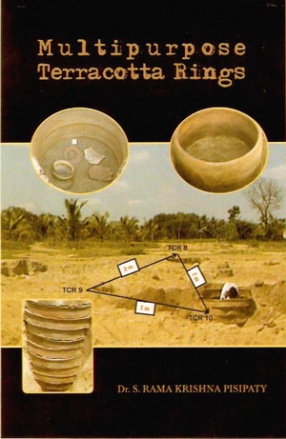Kanchipuram is one of the important urban centres in Tondaimandalam (now in Tamil Nadu state) in the southern part of India from the very beginning. The river Vegavathi and Palar are important rivers systems in the area. During 2006 and 2008 field seasons archaeological excavations were conducted by the SCSVMV University team at the Palar and Vegavathi river basin, near Kanchipuram. Many new socio-cultural traits have been noticed in this area. Hundreds of Terracotta rings were traced from the dried channel of river Vegavathi. These were not utilized for a single purpose. Further, the mud made backed rings have been utilized not only for different domestic activities but also for the construction of memorials. Hundreds of rings from one settlement are not only a unique feature but also first time reported in the archaeological excavations. Terracotta rings in funerary architecture is not only a new adoption in burial practice but also reported for the first time in India and else where. It further indicating a new socio-cultural trend at Kanchipuram. Many new evidences from the archaeological excavations in the Vegavathi river dried channel at Kanchipuram have published in this book.
ABOUT THE AUTHOR S Rama Krishna Pispity
Prof. S. Rama Krishna Pisipaty has been teaching Indian Culture at Sri Chandrasekharendra Saraswathi Viswa Mahavidyalaya (SCSVMV University) of Kanchipuram, Tamil Nadu in southern part of India from the past twelve years. Doctorate from Banaras Hindu University, Varanasi, India has carried out archaeological fieldwork in various parts of Andhra Pradesh and Tamil Nadu. Professor Pisipaty's excavations cover a vary wide range from Paleolithic to Medieval. Among all, 2006 & 08 excavations in the Vegavathi dried river channel near Kanchipuram were significant. Multipurpose terracotta rings, lithic funerary tradition with in the terracotta rings, ring built monuments, etc., were recovered first time in India and elsewhere in the mortal architecture. Further, 2009 & 2010 excavations at Singadivakam near Kanchipuram provide an evidence of continuous human activities right from the Early Stone Age at Kanchipuram region. At Singadivakam during 2010 field season, early Stone Age tools both finished and unfinished along with raw material have been noticed for the first time near Kanchipuram. Besides, a good number of fossils were also recovered form the Singadivakam excavations. He has attended and presented many papers in various national and international conferences in India and abroad. Visited USA, Germany, UK, Ireland, etc., for presenting research papers, academic discussions and research work.He is an author of a book titled - Andhra Culture: An Obscure Phase in the Early Historical Archaeology of Andhra Pradesh.





There are no reviews yet.